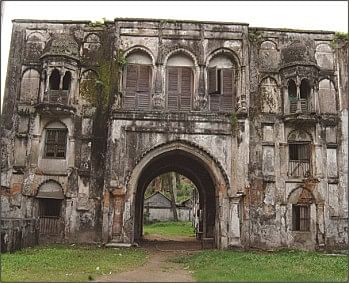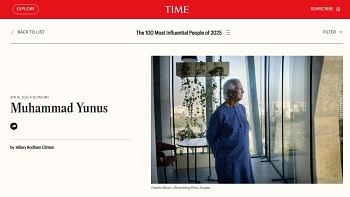Nimtali Deuri falling apart

Nimtali Deuri, the grand entrance to the Nimtali Palace, still heralds the city's glorious past.Photo: Syed Zakir Hossain
Nimtali Deuri, the last remaining gateway to the now-extinct 18th century Nimtali Palace, is now in a ramshackle state due to the lack of necessary steps to preserve it.
Experts said the Deuri, which means gateway, is quite 'fragile' at present and it needs immediate restoration to preserve the glorious past of the 400-year-old city.
“Already a few blocks have come off the walls of the structure. Unless restored, the structure will undoubtedly collapse in the next few years,” said Prof Sirajul Islam, renowned historian and president, Asiatic Society Bangladesh (ASB).
The Deuri, situated on the premises of ASB, is now being looked after by the society.
During a visit to the Mughal-era building, this correspondent found the coating of the mixture of lime and surki (brick dust) has fallen at places in the structure.
Ornate windows, wearing a decrepit look, infuse a regal glory in the structure that bears the history of the Nawabs of Dhaka who resided in the palace till 1743.
The magnificent gateway in the middle of the structure stands with an air of splendour that instills a sense of pride into the hearts of the visitors.
The ASB has carried out a two-year survey for restoration of the building. The estimated cost of the restoration is around Tk 60 lakh, said sources at the society.
However, the ASB could not yet manage funds for starting the renovation work.
ASB sources said the restoration work will include lime concrete and finishing to stop water sipping from the ceiling, lime coating and colour wash on both sides of the walls, replacement of wooden doors, windows and bolts, lime terracing, welding work of RCC conceal beams of the walls, setting up of a collapsible gate at the mouth of the Deuri and doors with intricate wooden designs of that time.
To prevent alleged blunders committed at the time of restoring the Panam City at Sonargaon, the ASB has taken up some precautious measures that will help preserve the structure in its original design and shape.
“We have seen that in Panam City contactors replaced the slender bricks of that time with oversized bricks of present time and plastered all the intricate designs marring the beautiful edifices,” said Prof Islam.
“To avoid this kind of blunders we have decided to make the materials for restoration at the spot. We will make the oven inside our premises so that bricks, brickbats and brick dust are specially made to match their previous counterparts,” he added.
“We are trying to bring some artisans from India who has experience in heritage site restoration,” said Prof Islam, also chairman of the subcommittee for the restoration.
Terming the half-demolished state of the nearly 600-year old Binat Bibi mosque 'atrocious,' Prof Islam said that very few Mughal period structures remain in the city but they are falling apart due to apathy and lack of awareness.
He said that Nimtali Deuri is an interesting feature of Mughal architecture. From north it looks like a gate and from south it looks like a palace.
“We should preserve this because there are very few Mughal period buildings in Bangladesh which are still in their previous shape. Nimtoli Deuri is one of them.”
He also said: “The Deuri has immense heritage value because this building signifies the glory and glamour of late Mughal period.”
The Asiatic Society is now planning to appeal to the government and the public for collecting funds for the renovation of the structure.
“We have not approached the government yet, but we have launched the campaign nationally. We are expecting that the government will provide fund for it in the interest of the conservation of national heritage and culture,” he said.
History of Nimtali Palace and the Deuri
Built towards the end of the Mughal rule, Nimtali Palace was the official residence of Naib-e-Nazim or deputy governor of Dhaka province during 1765-66. It was popularly known as the Nimtali Kothi, which once had four gateways. Nimtali Deuri is the last remaining gateway of the palace.
The now-extinct palace consisted of a number of separate buildings and occupied a vast tract of area between the Nimtali mahallah and the High Court building. It was situated at the periphery of the city mostly surrounded by woodlands.
Apart from the gateways, the palace also had inner court, private residences, place of prayers, water tanks, barracks for soldiers and quarters for staff.
A narrow channel running from the north would draw water from the Kamalapur River in the east to supply water to the palace.
The palace played a significant role in the social and cultural arena of Dhaka. It was the bastion of Mughal culture in Dhaka patronising classical music and dance, painting, arts, crafts and artisans. One colourful event that took place here regularly was the Eid procession, which used to start from and ended at the Nimtali Deuri.
Bishop Heber who visited Dhaka in 1824 gives a graphic description of the palace complex although most of it was then in ruins.
He mentions a “really handsome gateway [Nimtali Deuri] with an open gallery, where the 'Nobut', or evening martial music, is performed, a mark of sovereign dignity … a very handsome hall, an octagon, supported by gothic arches, with a verandah round it, and with gothic windows …”
Heber also mentioned one chamber with twelve doors known as 'Baraduari' for the individual entrance of the 12 Sardars (leaders) of the mahallas of the city.
(Source: Banglapaedia and an article by Dr Sharif Uddin Ahmed, professor, Department of History, University of Dhaka)

 For all latest news, follow The Daily Star's Google News channel.
For all latest news, follow The Daily Star's Google News channel. 



Comments